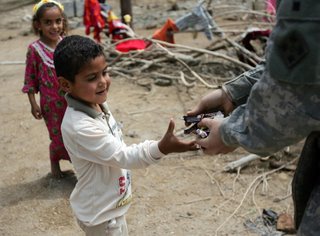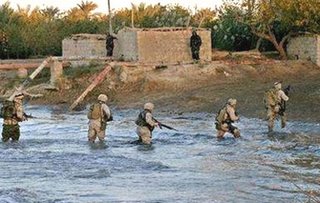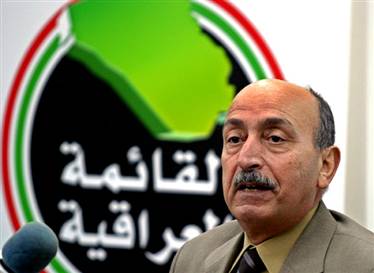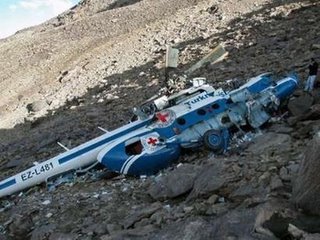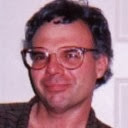Tuesday, June 27
*****
Sangin Valley, Sangin District, Helmand Province, Early AM: RPG attack on a British patrol here killed 1 British soldier. Heavy fighting ensued and another British soldier was wounded. He died of his wounds later. Altogether, 2 British soldiers were killed here and one more British soldier was wounded.
 British troops fan out across the parched landscape of the Sangin District on April 17. 2 British soldiers were killed here on Tuesday, June 27, when Taliban fighters ambushed their convoy near here.
British troops fan out across the parched landscape of the Sangin District on April 17. 2 British soldiers were killed here on Tuesday, June 27, when Taliban fighters ambushed their convoy near here.Sangin continues to be one of the most unstable areas of the horribly unstable Helmand Province. 13 Taliban were reportedly killed in heavy fighting, including air strikes, that followed the initial attack and went on for 4 hours. The Taliban claimed that they destroyed a number of British vehicles.
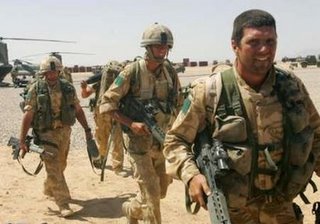 British troops return from a mission to Camp Bastian near Sangin on June 20. Note the exuberant expressions.
British troops return from a mission to Camp Bastian near Sangin on June 20. Note the exuberant expressions.Monday, June 26
Bagram Airbase: Suicide car bomb attack on a US convoy near here killed the bomber and wounded 2 Afghan civilians.
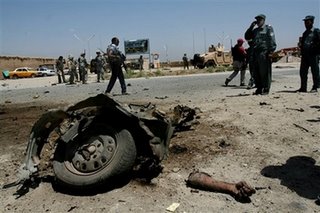 This is what was left over after a Taliban suicide car bomber attacked a US convoy outside the US Bagram Airbase. Note the severed limb, either an arm or a leg, of the suicide bomber in the foreground.
This is what was left over after a Taliban suicide car bomber attacked a US convoy outside the US Bagram Airbase. Note the severed limb, either an arm or a leg, of the suicide bomber in the foreground.Sunday, June 25
Pech District, Kunar Province: Fighting here killed 1 US soldier. Details were lacking. The Pech District is extremely dangerous.
Kamdesh District, Nuristan Province: The five health officials kidnapped here by guerrillas last week were released. 2 were doctors, 2 were provincial health officials and 1 was a Swedish NGO worker. Tribal elders forced the terrorists to release the hostages.
Saturday, June 24
*****
Panjwayi District, Late: A four-hour gunbattle erupted here between the Taliban and Coalition forces. 2 soldiers were wounded during the fighting but later died in the hospital. Another Coalition soldier was wounded. Altogether, 2 Coalition troops were killed and 1 more was wounded. 45 Taliban were killed in the fighting.
 Canadian forces raid mud-brick homes in Zangadin, Panjwayi Province. 2 Coalition troops were killed and 1 more was wounded in fighting in Panjwayi on Saturday, June 24.
Canadian forces raid mud-brick homes in Zangadin, Panjwayi Province. 2 Coalition troops were killed and 1 more was wounded in fighting in Panjwayi on Saturday, June 24.At first 8-10 guerrillas attacked but later fled to a compound where they were joined by a much larger group. Coalition forces then attacked the compound, killing 45 Taliban.
 Afghan police patrol in Panjwayi District. The Afghan police are poorly armed; the Taliban often have better weapons.
Afghan police patrol in Panjwayi District. The Afghan police are poorly armed; the Taliban often have better weapons.Kamdesh District, Nuristan Province: Five Afghan medical workers were abducted while driving here in this very wild, forested, jungle-like and extremely dangerous province.
Friday, June 23
Chinoh, Shahjoy District, Zabul Province: The Taliban seized 4 men this village. a checkpoint, accused them of spying for the US, and decapitated them. Their headless bodies were found today and yesterday.
Fayzabad, Badakhshan Province: Roadside bomb attack here on a Danish military convoy carrying the Danish commander-in-chief for Afghanistan, Hans Jesper Helso, wounded 1 Danish soldier and damaged an LAV. The mysterious roadside bomb attacks in mostly-Tajik Fayzabad continue, with no reasonable explanations on who is carrying them out. The Taliban have little to no presence here.
Thursday, June 22
Near Tirin Kot, Uruzgan Province: US troops raided a cave complex here that the Taliban were using as a meeting and hiding place. 8 guerrillas were killed in the raid and 6 more were arrested. A cache AK-47's., RPG's and two machine guns was seized. There were no Coalition casualties.
*****
Wednesday, June 21
Sangin, Sangin District, Helmand Province, early AM: A large British paratrooper force was airlifted here to retake the town from Taliban who overran it earlier, battling police and a local militia, and killing 32 people.
*****
Near Tirin Kot, Uruzgan Province: US forces intercepted a Taliban force traveling back and forth between a weapons bunker as they tried to set up an ambush of Coalition forces. The Taliban force was attacked and 17 Taliban were killed. There were no Coalition casualties.
Helmand Province: Six Taliban fighters were killed in an attack here.
*****
Kamdesh District, Nuristan Province: US troops battled guerrillas in northern Nuristan. The Taliban, Al Qaeda, Hezb-i-Islami and Lashkar-e-Toiba, a Pakistani group are all operating in this very remote and extremely dangerous province. During the fighting, 4 US troops were killed and 1 more was wounded.
US aircraft joined the attack and 2 guerrillas were killed. Calling in air support here is like calling in air strikes in Vietnam - you can hardly see the enemy at all and from the air, you can just see towering peaks, plunging valley, rocks and forested jungles.
In my opinion, bin Laden and Zawahiri are possibly hiding here in Nuristan. The tribes here have an ancient code that mandates that they protect visitors who ask to be protected from outsiders. This area was formerly known as Kafirstan, because the residents were non-Muslim pagans, until Muslims conquered it and Islamicized it in 1897.
There is a bewildering plethora of small ethnic groups in this area and many different languages are spoken. Most of these languages are related to Iranian in some way.
The region is so inaccessible that a situation similar to the Caucasus or parts of New Guinea has arisen, with tribes in deep mountain valleys speaking different languages. Since it is so hard to go from one valley to the next, the different languages persist due to limited contact. In contrast, in wide, flat areas, smaller languages tend to go out and you often end up with one language spoken over hundreds of miles.
The Muslims here have been very conservative for a long time and during the Afghan War, Salafis made strong inroads here. The Russians never really conquered this province during the war.
The women are supposedly beautiful but the few Westerners who have visited the province say that you can only see them when they are young girls, and after that, they are out of sight. Recent reports indicate that local tribal leaders are being abused by Salafist guerrillas who have overran the province and imposed their writ on the local tribes, who seem to be powerless to stop them.
****
Kandahar: A suicide attacker detonated his explosives-filled car near a military convoy in the city of Kandahar, killing one and wounding nine, Afghan and coalition officials said. Two Canadian soldiers were injured and the attacker was killed. In addition, an Afghan bystander was killed and seven others injured, including one policeman and six civilians.
 Aftermath of the suicide car bomb attack in Kandahar on June 21. 2 Canadian soldiers were wounded in this attack.
Aftermath of the suicide car bomb attack in Kandahar on June 21. 2 Canadian soldiers were wounded in this attack.Germany: Romanian soldier Sgt. Costinel Valerica Slaniceanu, critically wounded in the roadside bomb attack in Kandahar Monday night that destroyed a Romanian tank, was evacuated to a hospital in Germany for further treatment.
Shah Wali Kot District, Kandahar Province: Roadside bomb attack on Canadian convoy here wounded 4 Canadian soldiers, 1 seriously. 2 Taliban were arrested nearby and suspected of detonating the bomb.
Southern Afghanistan: A Canadian armored vehicle rolled over, wounding 2 Canadian soldiers.
Tuesday, June 20
*****
Musa Qala, Helmand Province: US and Afghan troops battled Taliban fighters near here, killing 20 Taliban. 1 Afghan soldier was wounded.
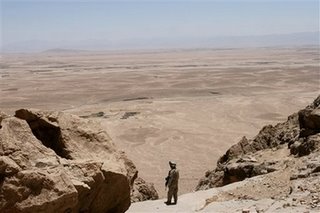 Musa Qala, land of desolation in northern Helmand Province. 20 Taliban were killed here on Monday, June 19.
Musa Qala, land of desolation in northern Helmand Province. 20 Taliban were killed here on Monday, June 19. Two Afghans outside of Musa Qala waiting at a US checkpoint. Note the typical black turbans worn by the Taliban. Note also the hard, distrustful faces.
Two Afghans outside of Musa Qala waiting at a US checkpoint. Note the typical black turbans worn by the Taliban. Note also the hard, distrustful faces.Torkham Crossing, Afghanistan/Pakistan Border: A bomb attached to a fuel tanker supplying fuel to US forces in Afghanistan exploded as the vehicle crossed over into Afghanistan from Pakistan, killing six people and destroying 10 trucks. A fuel tanker behind it caught on fire and the fire spread to eight other trucks.
Bagram Valley, Bagram District,Helmand Province: British troops pushed deep into the Bagram Valley in Helmand Province, today pushed deep into rebel territories in southern Afghanistan that have not been under government control for 30 years. Troops are using small arms and artillery to battle Taliban fighters here, and Apache helicopters have been used by the British for the first time.
 US forces being airdropped on top of a desolate mountain in Bagram Valley, where they planned to set up a base and cut off Taliban supply lines.
US forces being airdropped on top of a desolate mountain in Bagram Valley, where they planned to set up a base and cut off Taliban supply lines. US forces take up position on a mountain ridge in the Bagram Valley, a place that has not seen Coalition forces since the fall of the Taliban. Later, US aircraft bombed a Taliban position in the valley below.
US forces take up position on a mountain ridge in the Bagram Valley, a place that has not seen Coalition forces since the fall of the Taliban. Later, US aircraft bombed a Taliban position in the valley below.*****
Sangin, Sangin District, Helmand Province: The Taliban ambushed the home of the former Helmand Province intelligence chief, Dad Mohammad Khan, setting off a 12-hour battle between the Taliban, Khan's militia and police that killed 32 people, wounded 4 more and left 10 people missing.
The ambush began when Taliban forces attacked vehicles carrying the brother a former district chief, Dad Mohammad Khan. Several hours later, around 40 of the Khan's relatives went to collect his body and were ambushed with the loss of 25 lives, Khan said.
The battle raged for 12 hours and took place only an hour from a US military base. The US troops never came to help the besieged Afghans and the relatives of the dead Afghans are furious.
*****
Monday, June 19
Kandahar, Night: Taliban militants detonated a roadside bomb on a Romanian tank, destroying the tank and killing 1 Romanian soldier, Cpl Ionel Gheorghita, and wounding 3 others. 1 of the soldiers, Sgt Costinel Valerica Slaniceanu, was critically wounded. That must have been a pretty potent bomb to destroy a tank.
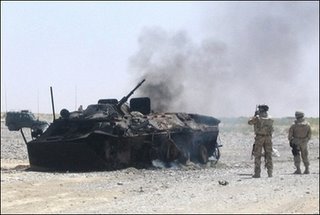 Troops inspect the ruins of a Romanian tank destroyed by a roadside bomb near Kandahar. 1 Romanian soldier was killed and 3 more were wounded, 1 critically. It must have been a very powerful roadside bomb to take out a tank. Often anti-tank mines are used for bombs like this. In Iraq, guerrillas has been known to pile three 150-lb antitank mines on top of each other to destroy a US Abrams tank.
Troops inspect the ruins of a Romanian tank destroyed by a roadside bomb near Kandahar. 1 Romanian soldier was killed and 3 more were wounded, 1 critically. It must have been a very powerful roadside bomb to take out a tank. Often anti-tank mines are used for bombs like this. In Iraq, guerrillas has been known to pile three 150-lb antitank mines on top of each other to destroy a US Abrams tank.*****
Zabul Province: Villagers here are finding themselves trapped between Taliban guerrillas and abusive government soldiers. In the Shajoy District, only 1 of 31 schools is open - all the rest have shut down under orders of the Taliban. In Qalat, the capital, the hospital is 50% empty. They cannot fill positions because doctors and nurses are too afraid to work there.
******
US and Afghan forces present Zabul as a smashing success. The previously corrupt government has been thrown out and a clean one installed instead. Millions in reconstruction funds have poured into the province and the police and army have been retrained and have received new weapons.
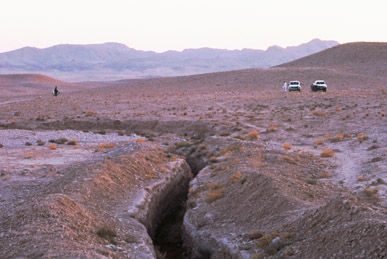 A minefield near an ancient canal in Zabul Province, near Qalat. There is actually some vegetation growing here.
A minefield near an ancient canal in Zabul Province, near Qalat. There is actually some vegetation growing here.Yet Shahjoy District is seriously overrun with Taliban and even the main Kandahar-Kabul Highway, the government's prize, is avoided by most foreigners. Government soldiers, many of whom are ethnic Tajiks, often beat and abuse locals, whom they accuse of helping the Taliban.
 An incredibly desolate desert scene in Zabul Province. How do you fight a war in a place like this? Where do you hide?
An incredibly desolate desert scene in Zabul Province. How do you fight a war in a place like this? Where do you hide?But locals complain that they have no choice but the help the Taliban when they show up in the village. US and Afghan officials said that guerrillas pouring across the border from Pakistan play a major role in the worsening security situation.
******
Sunday, June 18
****
Bagram Valley, Bagram District, Helmand Province: U.S. soldiers set up a fortified position on a mountain ridge here, marking the first time in years that soldiers had been in this area.
 US forces were airlifted into a position on a remote mountaintop in the Bagram Valley in an effort to cut off the Taliban and take them by surprise.
US forces were airlifted into a position on a remote mountaintop in the Bagram Valley in an effort to cut off the Taliban and take them by surprise.This is part of a major Coalition offensive designed to cut off Taliban supply lines and, in my opinion, keep the Taliban from massing in this area, which is a route towards Herat to the northwest and Kabul to the northeast. I believe that the Taliban are massing in here hoping to eventually move towards those two main cities.
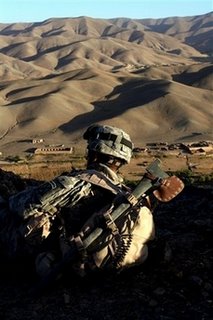 A US soldier overlooking the US position in remote Bagram Valley in northern Helmand Province.
A US soldier overlooking the US position in remote Bagram Valley in northern Helmand Province. US forces in northern Helmand Province, probably in the Bagram Valley.
US forces in northern Helmand Province, probably in the Bagram Valley.Kandahar: There are now reports that the Taliban is threatening to attack Kandahar. Taliban sources indicate that the group has been making preparations for an assault on the city for the last three or four months. They are reportedly stockpiling weapons and hiding in Loy Wiyala, a huge slum on the northern end of town.
Helmand Province: Taliban fighters attacked a convoy carrying a former provincial chief, killing him and his 4 bodyguards.
Shahjoy District, Zabul Province: Police and Coalition forces killed 2 guerrillas and wounded 2 more in fighting here. The wounded guerrillas were arrested.
Tarin Kot, Uruzgan Province: US and Afghan forces raided a Taliban stronghold near here and battled fighters for three hours, killing 7 Taliban and wounding 4 more. The wounded fighters were all arrested. A numbers of others escaped into the rugged mountains.
Saturday, June 17
Kajaki Dam, Kajaki District, Helmand Province, Late: Taliban forces fired mortars at British troops guarding this dam. British troops fired mortars back at the Taliban, killing 6 fighters. This is one of the few hydroelectric dams in Afghanistan and guerrillas have been firing mortars at it lately.
 British troops take up position fighting in the cauldron known as Helmand Province on June 21. The location is unknown, but I suspect they may be near Gereshk, 23 miles southwest of Sangin.
British troops take up position fighting in the cauldron known as Helmand Province on June 21. The location is unknown, but I suspect they may be near Gereshk, 23 miles southwest of Sangin. Kajaki Lake in Helmand Province. The Taliban has been firing mortars at the dam here lately. It's hard to imagine what would happen if the dam broke.
Kajaki Lake in Helmand Province. The Taliban has been firing mortars at the dam here lately. It's hard to imagine what would happen if the dam broke. Kajaki Lake in Helmand Province, scene of fighting when the Taliban fired mortars at British troops guarding the dam. This huge lake looks strange in such a desolate desert. What is even more strange is that no vegetation seems to have sprouted around the edges of this lake.
Kajaki Lake in Helmand Province, scene of fighting when the Taliban fired mortars at British troops guarding the dam. This huge lake looks strange in such a desolate desert. What is even more strange is that no vegetation seems to have sprouted around the edges of this lake.Friday, June 16
Asadabad District, Kunar Province: Roadside bomb attack on US troops here destroyed an all-terrain vehicle and killed 2 US soldiers.
Thursday, June 15
Bagram Base, Kabul: US Capt. Patrick D. Damon died here from a non-combat related cause.
June 14
*****
Musa Qala, Helmand Province: Small arms attack on a US convoy here killed US Sgt. Roger P. Pena Jr.
 The desolate landscape near Musa Qala, where Sgt. Pena was killed in a small arms attack. It's hard to see how you could ambush anyone in a place like this.
The desolate landscape near Musa Qala, where Sgt. Pena was killed in a small arms attack. It's hard to see how you could ambush anyone in a place like this.Tuesday, June 13
Korengal, Kunar Province: Small arms attack on US forces here killed US Sgt. Russell M. Durgin.
June 5
FOB Salerno, Khost Province: The soldier who died here of a noncombat-related cause, Cpl. Derek A. Stanley, was, in my opinion, a suicide, but that has not yet been officially confirmed. At the time, the military only revealed that hostile action or foul play was not suspected. What this means, apparently, is that the soldier died of a gunshot wound.
 US forces from the 504th Parachute Infantry Regiment on a mountainside, probably near FOB Salerno. FOB Salerno is in Eastern Paktika Province near the Pakistani border. Note how much more vegetated it is here in Paktika than in Zabul, Helmand and Kandahar.
US forces from the 504th Parachute Infantry Regiment on a mountainside, probably near FOB Salerno. FOB Salerno is in Eastern Paktika Province near the Pakistani border. Note how much more vegetated it is here in Paktika than in Zabul, Helmand and Kandahar.




